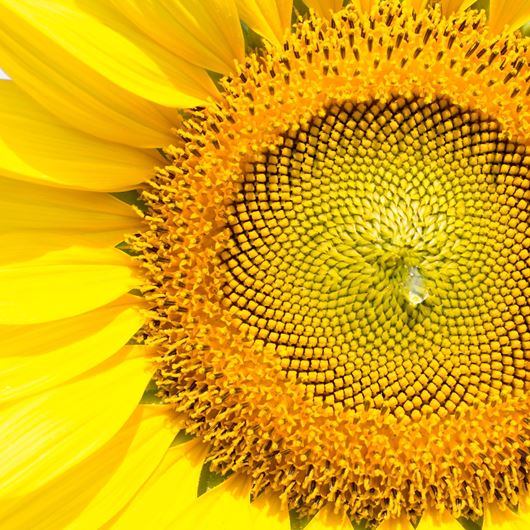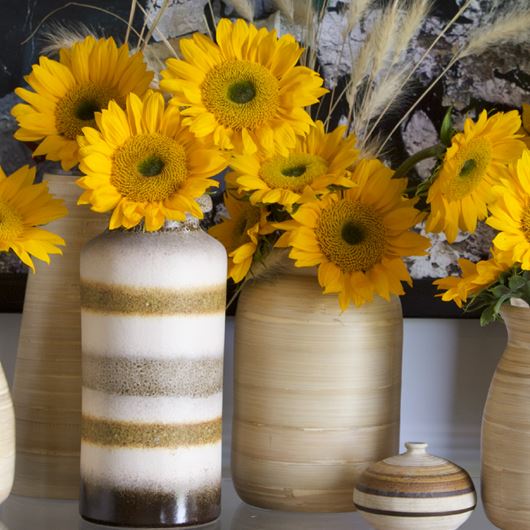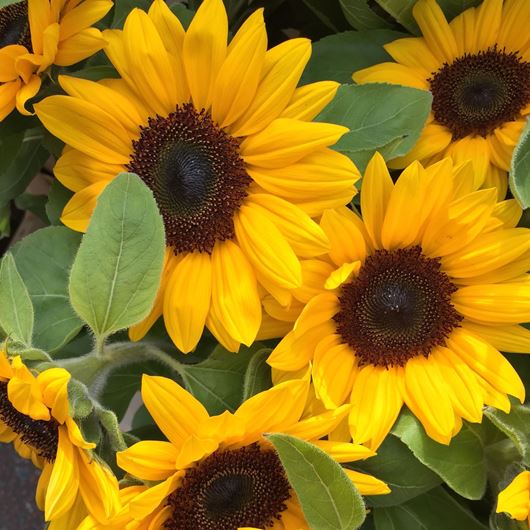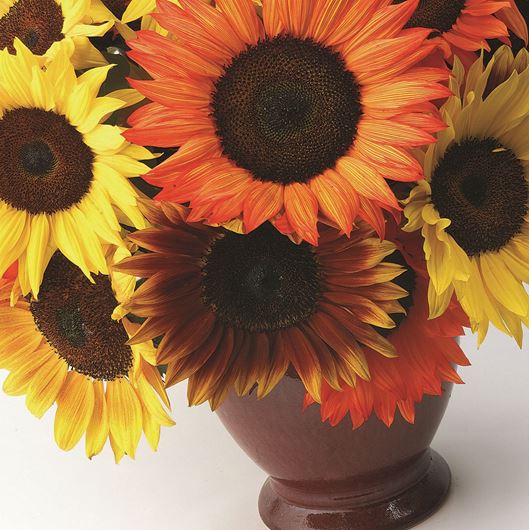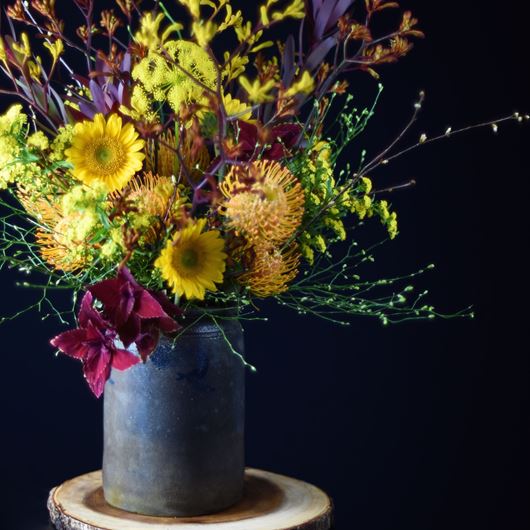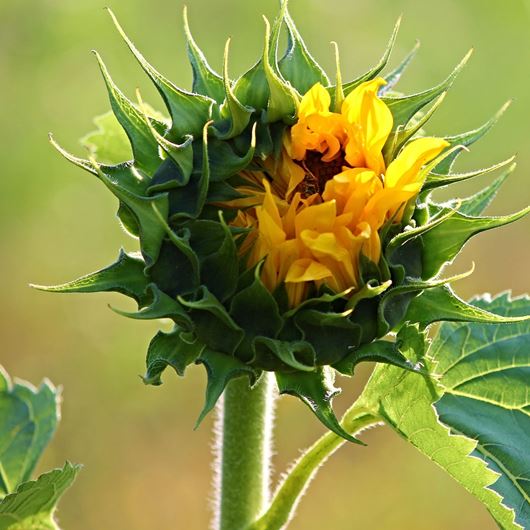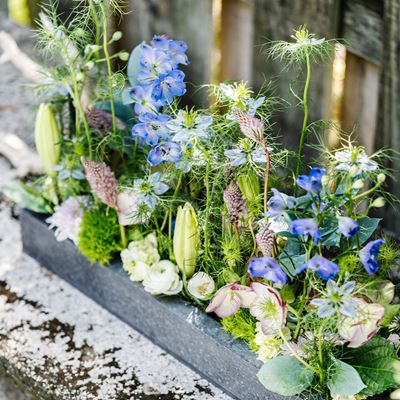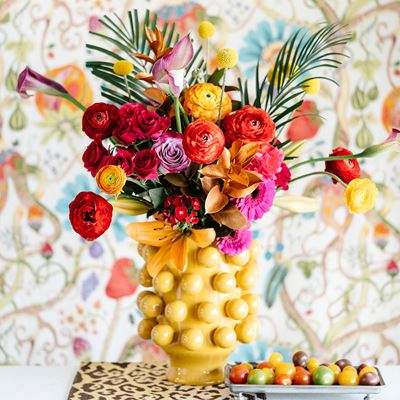Completing our 2023 lookbook series, our sixth and final trend, ATMOSPHERIC, pays homage to our planet's habitats at large. This trending macro view gathers an immersive palette of cool hues, borrowed from the oceans and forests, and pairs it with glowing bright white.
The Surprising Sunflower Energizes Body, Soul and Planet
Don’t let that sunny face fool you. This is no humble prairie weed. It’s a world-traveling powerhouse of beauty and nourishment, and has helped to saved the earth—quite literally.
The classic sunflower disguises itself as a simple blossom resembling a super-sized version of its cousin, the daisy. Both are composite flowers, meaning that each flower head is actually a community of smaller blooms: the outer circle of ray florets, which look like petals surrounding the round center of shorter, denser disc florets.
In sunflowers grown for consumption, the disc florets mature into edible seeds. Newer F1 hybrids created for the cut flower industry do not develop seeds. Most don’t even make pollen, but even the ones that do are considered allergy-safe by The American Academy of Allergy, Asthma and Immunology.
Most florist sunflowers bloom as a single 2 - 7" (5 - 18 cm) diameter flower head on a sturdy, hairy stem with large, deep green, heart-shaped leaves. Depending on the cultivar, sunflowers can grow from six inches to 12 feet tall, but most florist stems are 18 - 36" (46 - 92 cm).
There are double and multi-flowering cultivars in a variety of warm colors, and new mini and multi-branched hybrids are gaining popularity, but the classic yellow-fringed single sunflowers are still the consumer favorite.
Sunflowers are named not only for their appearance, but for their habit of keeping their developing flower heads constantly turned toward the sun. This is called heliotropism, from the Greek helios (sun) and tropos (to turn or change). Once the ray florets have opened completely, sunflowers face east full-time. Science has not yet confirmed why.
Discover more of the humble sunflower’s unexpected super powers in the “Fun Facts” section below.
FUN FACTS
• Humans have grown, eaten and worshiped the sunflower for 5,000 years—even longer than corn! The Inca in Peru and Aztec in Mexico revered the flowers as a symbol of their sun gods in temples, ceremonies and adornments. Spiritual leaders and ruling classes wore the fresh flowers and fashioned sunflower-themed crowns, clothing and jewelry. The plains tribes left bowls of seeds on their ancestors’ graves to sustain them in the afterlife.
• Ancient farmers ground the tiny seeds into flour for tortilla-like bread, porridge, and thickened stews and drinks. They squeezed oil from the kernels for body paints and salves. They used the leaves, petals, roots and stalks to make medicinal teas, poultices, dyes, textiles and building materials. And sometimes they just cracked the seeds and munched, just as we do 5,000 years later.
• When the Spanish explorers arrived around the year 1500, the indigenous people proudly shared their sacred plant, and the conquistadors eagerly carried the seeds on their voyages home. Sunflowers quickly became popular across Europe, but were used primarily as garden and medicinal flowers until the 18th century, when the Russian tsar Peter the Great took an interest in them as an oil crop.
• By the 19th century, sunflower oil was a commercial crop in Russia, and horticulturists were perfecting two types of cultivars. One grows small, oil-rich black seeds for pressing. The other grows those tasty striped seeds on the giant, single-blossomed plants which we think of as classic sunflowers today.
• The sunflower industry got a lucky boost in the early 1800s, when the Russian Orthodox Church banned most traditional cooking oils from use during Lent. Sunflower oil was an exception, and almost overnight, it became a year-round staple in virtually all Eastern European kitchens. Even today, Russia and Ukraine produce more than half of the global sunflower seed crop, and two-thirds of the world’s sunflower oil. It should come as no surprise that the sunflower is Ukraine’s national flower!
• Meanwhile, back in 19th century North America, native sunflowers did not catch on as cash crop in the growing agricultural economy…until Russian immigrants brought their own seeds and introduced the “new” sunflower plant back to its land of origin. Heirloom “Mammoth Russian” sunflower seeds are still popular with home gardeners more than a century later.
• With demand for sunflower oil growing in Europe, both U.S. and Canadian governments introduced growing programs in the early 20th century. Today American farmers in the plains states and California produce enough to keep seed-loving Americans and backyard birds happily snacking, plus a modest amount of surplus oil for export.
• The sunflower continues to astonish and aid us with its seemingly endless uses. Its stalks can become paper, feed farm animals and float life preservers. The oil’s light flavor and high smoke point make it ideal for cooking, and it can be refined to make paint, soaps, lubricants, cosmetics and biofuels. The leaves, roots and oil are used in herbal medicine to soothe skin ailments, treat venomous bites, ease congestion and digestive discomforts, and cool fevers, to name a few. The heads can even be cooked and the petals eaten like artichokes.
• Sunflowers’ sunny good looks and hope-filled symbolism make it a favorite motif for décor, clothing, jewelry and even tattoos.
• Though humans have always appreciated the sunflower’s beauty, its use as a cut flower is quite new. The flower-loving Impressionist painters of the late 19th century had something to do with that. Particularly Vincent Van Gogh, who turned a rainy week, a stash of newly-invented paint pigments and an armload of his best friend’s favorite flowers into an artistic megahit. He created a series of four sunflower paintings to hang in the guest room for his visiting friend, fellow artist Paul Gauguin, who was blown away. Soon, the rest of the world was too. We still are. “The sunflower is mine, in a way,” Van Gogh later wrote. What a delicious understatement!
• Artists and designers aren’t the only people captivated by sunflowers. They are a mathematician’s dream of symmetry and pattern. The disc florets align in intricate spirals and counter-spirals, with new buds in the center nudging the maturing florets toward the edges as they grow. The pattern follows the Fibonacci Sequence (where the size of each number—or spiral, or floret—equals the previous two added together).
• Each diamond-shaped floret rotates exactly 137.5 degrees to nestle neatly between its neighbors like a puzzle piece. This is one of nature’s favorite patterns, the Golden Mean (placing an object equal distance from the others around it). Even the non-seed-producing florist hybrids grow in this fascinating and beautiful pattern.
• The sunflower’s most amazing super power is actually saving earth. Scientists call sunflowers hyperaccumulators; the New York Times calls them “toxic avengers with leaves.” Sunflowers grow enthusiastically in all kinds of soils, including those tainted by toxic metals and radiation, and as they grow, their roots absorb and remove the poisons. Harvesting and disposing of contaminated sunflower stalks is far easier and cheaper than scooping and encapsulating tons of topsoil. Sunflowers have been used to clear radiation on the Hiroshima, Chernobyl and Fukashima nuclear disaster sites, and to remove lead from industrial sites in Detroit. Decontaminating the earth with plants is called phytoremediation.
• Because of its radiation-neutralizing super power, the sunflower is used as an international symbol for nuclear disarmament.
• Native sunflowers still grow wild throughout the Americas, especially in the prairie states, where Kansas claims them as the state flower. These vigorous ancient cultivars are now being cross-bred with their over-domesticated descendants, to increase the commercial hybrids’ natural disease and pest resistance.
• Florist sunflowers are grown in fields and greenhouses across the globe. They are also a popular boutique crop for small growers supplying local florists and consumers.
• The sunflower is the third-wedding-anniversary flower.
• The sunflower’s botanical name, Helianthus annuus, is from the Greek helios (sun) and anthos (flower), with the Latin annuus (annual).
• There are more than 70 species in the Helianthus (sunflower) genus, but H. annuus is the only one we eat.
• Up to 2,000 seeds can grow on a single sunflower head.
• The tallest sunflower on record was grown in Germany in 2014 and measured more than 30'. The smallest was just over 2".
• Sunflowers can grow four feet per month!
Sunflowers are only one of the Flowers We Love, and we would love to share them all with you. Whether flowers are your passion or your profession, this living encyclopedia will expand your knowledge and entice your imagination. Visit often as we add entries to keep your floral skills growing.
